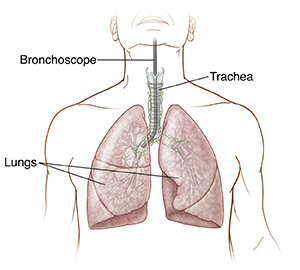Flexible Bronchoscopy
Flexible Bronchoscopy
A flexible bronchoscopy is an exam of the airways of your lungs. A thin, flexible tube called a bronchoscope is used. It has a light and small camera that allow the healthcare provider to view your airways.
Before your test
Follow your healthcare provider's instructions carefully. If you don’t, the exam may be canceled. Or you may need to take it again.
If you are taking blood-thinning medicine, ask your healthcare provider if you should stop taking the medicine before this test.
Have no food or drink for at least 8 hours before the test. Also, avoid smoking for 24 hours before the test.
You will need to remove any dentures or removable devices from your mouth.
Right before the test, you will be given sedating medicines to help you relax. The medicine may be given by an IV (intravenously) into one of your veins. In addition, your nose and throat may be numbed with a special spray to help prevent gagging and coughing.
If you are having this test as an outpatient, make sure you have an adult friend or family member to drive you home.
During your test
Bronchoscopy takes 45 to 60 minutes and includes the following steps:
You may be given medicine (anesthesia) so that you are unconscious or asleep during the procedure.
The healthcare provider inserts the tube into your nose or mouth.
If you have not been given anesthesia, you might feel a gagging sensation. To help ease this feeling, you will be told to swallow or take deep breaths. Your airway will remain open even with the tube in place. But you won’t be able to talk.
The provider checks your breathing passage. He or she may also remove tiny tissue samples for biopsy.
After your test
You may have a mild sore throat or cough. Your voice may also be hoarse.
Don't eat or drink until the anesthesia wears off.
If you had a biopsy, you might see traces of blood being coughed up.
When to call your healthcare provider
Call your healthcare provider right away if you have any of the following:
Shortness of breath
Chest pain
Bleeding from your nose or throat
Coughing up a large amount of blood
A fever above 100.4°F (38°C) for more than 24 hours
Call 911
Call 911 if you have:
Chest pain
Severe shortness of breath
Updated:
September 03, 2017
Sources:
Patient education:Flexible bronchoscopy (Beyond the Basics). UpToDate.
Reviewed By:
Blaivas, Allen J., DO,Image reviewed by StayWell medical illustration team.,Sather, Rita, RN
